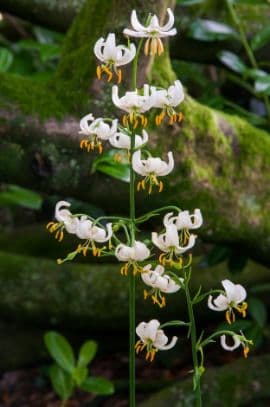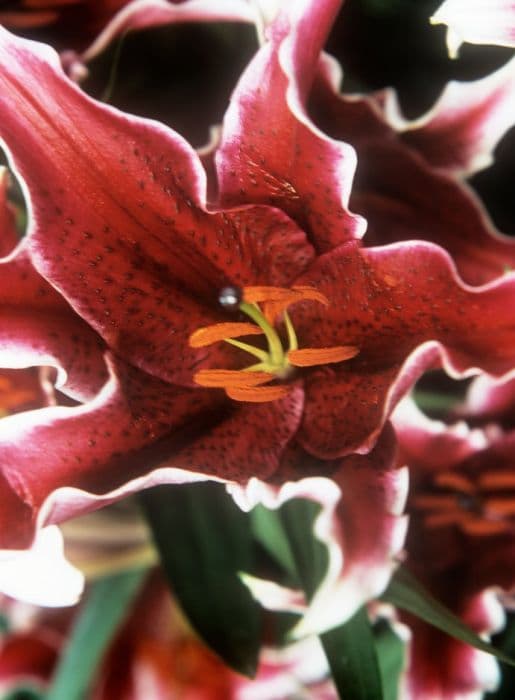Tulip Tulipa 'Dordogne' (5)

ABOUT
The Tulipa 'Dordogne', commonly known as a type of tulip, features a striking appearance that can be a highlight in any garden. These tulips are characterized by their vibrant and unique coloration. The petals boast a blend of warm tones, merging shades of orange, yellow, and sometimes a hint of pink. This gradient effect gives the sense of a sunset captured in the delicate texture of the flower's petals. The cup-shaped blossoms gracefully sit atop sturdy stems, which stand proudly among the plant's foliage. The leaves themselves are typically a rich, green color, and have a slightly wavy or smooth edge, providing an elegant backdrop for the vivid blooms. The overall look of the Tulipa 'Dordogne' is that of classic beauty with a touch of fiery warmth, making it a delightful addition to any floral setting where bold colors and enchanting shapes are desired.
About this plant
 Names
NamesFamily
Liliaceae.
Synonyms
Dordogne Tulip, Tulipa 'Dordogne'.
Common names
Tulipa 'Dordogne'
 Toxicity
ToxicityTo humans
The Tulipa 'Dordogne' is more commonly known as the Tulip. Tulips are not highly toxic to humans, but they do contain allergenic lactones and other compounds that can cause discomfort if ingested. Skin contact with tulip bulbs can also cause a rash known as "tulip fingers." If any parts of the plant or bulb are ingested, it could potentially lead to symptoms like nausea, vomiting, diarrhea, and irritation in the mouth and throat. While serious complications are uncommon, it is advisable to seek medical attention if any adverse reactions occur after ingesting parts of the tulip.
To pets
The Tulip, specifically the Tulipa 'Dordogne', is toxic to pets, especially cats and dogs. All parts of the tulip contain allergenic lactones known as tuliposides, but the bulb is the most toxic part. If a pet ingests tulip bulbs, leaves, or stems, they may exhibit symptoms such as vomiting, diarrhea, drooling, and increased heart rate. Serious cases can lead to central nervous system depression, difficulty breathing, and even death, particularly if large quantities of the bulb are ingested. It is important to prevent pets from accessing tulips and seek veterinary care immediately if you suspect tulip poisoning.
 Characteristics
CharacteristicsLife cycle
Perennials
Foliage type
Deciduous
Color of leaves
Green
Flower color
Orange
Height
2 feet (60 cm)
Spread
6 inches (15 cm)
Plant type
Bulb
Hardiness zones
3
Native area
Central Asia
Benefits
 General Benefits
General Benefits- Attractive Blooms: Tulipa 'Dordogne', commonly known as the Dordogne Tulip, has vibrant, color-graded flowers that are visually appealing and add aesthetic value to any garden.
- Pollinator Friendly: The blossoms attract bees and other pollinators, contributing to the health of your garden's ecosystem.
- Easy to Grow: Dordogne Tulips are low maintenance, making them suitable for beginners and those with limited gardening time.
- Spring Interest: These tulips bloom in spring, providing early color in gardens after the winter season.
- Cut Flower Use: The sturdy stems and long vase life make Dordogne Tulips ideal for cut flower arrangements.
 Medical Properties
Medical PropertiesThis plant is not used for medical purposes.
 Air-purifying Qualities
Air-purifying QualitiesThis plant is not specifically known for air purifying qualities.
 Other Uses
Other Uses- Tulip petals are edible and can be used as a colorful garnish in salads or as an adornment on desserts, adding a subtle flavor and a touch of elegance.
- The vibrant colors of Tulipa 'Dordogne' tulips can be used as a natural fabric dye, infusing textiles with hues that reflect their distinctive orange and yellow tones.
- The stems and petals of the tulips can be incorporated into eco-friendly confetti, decomposing naturally without harming the environment.
- Their strong stems allow Tulipa 'Dordogne' tulips to be used in structural floral designs, providing support for other, more delicate flowers in an arrangement.
- Tulip bulbs can be used in a form of energy storage known as "biomass" to potentially generate heat or electricity through bioenergy processes.
- The bulbs of the tulips can be utilized as a natural pest deterrent when crushed and scattered around gardens, as certain compounds they contain may repel some insects.
- During the blooming season, Tulipa 'Dordogne' can be used to create natural corridors or mazes in large garden spaces, offering a sensory walk-through experience.
- The flowers can be used in artisanal crafts, such as pressing for decorative bookmarks, greeting cards, or framed botanical art.
- Tulip blossoms can serve as organic vessels for serving appetizers or holding soft spreads during fancy garden parties or eco-friendly events.
- The tulip can play a role in educational settings, where students can study pollination and plant growth cycles, as well as the art of hybridization and plant breeding.
Interesting Facts
 Feng Shui
Feng ShuiThe Tulip is not used in Feng Shui practice.
 Zodiac Sign Compitability
Zodiac Sign CompitabilityThe Tulip is not used in astrology practice.
 Plant Symbolism
Plant Symbolism- Perfect Love: Tulipa 'Dordogne' is a variety of tulip, and tulips in general are often associated with perfect love, based on a Turkish legend that dates back to the time of the Ottoman Empire, symbolizing the love between Farhad and Shirin.
- Declaration of Love: The tulip's bold shape and colors are considered a declaration of one's love, making the flower a popular choice for romantic occasions.
- Renewal: Since tulips are among the first flowers to bloom in the spring, they symbolize rebirth and renewal.
- Royalty: Tulips, including the 'Dordogne' variety, have historically been prized by kings and emperors, thus they are associated with royalty and elegance.
- Prosperity: During the Tulip mania in the 17th century, tulips became extremely expensive and were a sign of wealth, leading to their connection with prosperity.
 Water
WaterTulips, including the Tulipa 'Dordogne', should be watered thoroughly at the time of planting with about a gallon of water per square foot of soil. Afterward, during the growing season, they require minimal additional watering unless the weather is particularly dry. Adequate moisture is essential when the plant is actively growing, so water them every week if there is no significant rainfall, providing about half a gallon per square foot. Tulips prefer not to be waterlogged, so ensure that the soil drains well to prevent bulb rot. After the tulips have bloomed and the leaves begin to yellow, watering can be reduced as the plant enters dormancy.
 Light
LightTulips, like the Tulipa 'Dordogne', thrive in full sunlight but can also tolerate partial shade. The ideal location for planting tulips is an area that receives at least six hours of direct sunlight daily. Filtered light conditions can be acceptable, but for the most vibrant blooms and strongest growth, aim to plant them in a spot that enjoys unobstructed sun throughout the day.
 Temperature
TemperatureTulips, including the Tulipa 'Dordogne', prefer cool to moderate temperatures and are hardy in a range from 20°F to -20°F during their dormant period. The ideal flowering temperature for tulips is between 50°F and 65°F. Extended periods above 70°F may shorten the bloom time and affect overall vigor. It is important to ensure good soil drainage to prevent bulbs from freezing and rotting in cold, soggy ground.
 Pruning
PruningPruning the Tulipa 'Dordogne', or tulips in general, consists mainly of deadheading the spent blooms after flowering to prevent seed formation, which can drain energy from the bulbs. Once the foliage turns yellow and dies back, usually several weeks after blooming, it can be removed too. This usually occurs once a year, post-flowering. The best time to prune is after the blossoms have faded but while the leaves are still green if deadheading, and once the leaves die back for removing the foliage.
 Cleaning
CleaningNot needed
 Soil
SoilFrench tulips like Tulipa 'Dordogne' require well-draining soil with a neutral to slightly acidic pH of 6.0 to 7.0. A mix of loamy soil, compost, and sand at equal ratios is ideal to ensure appropriate drainage and fertility. For container growing, a sterile potting soil amended with perlite and organic matter is recommended.
 Repotting
RepottingFrench tulips typically do not need frequent repotting. Bulbs should be planted in the fall, and after the flowering season, they can be lifted and stored in a dry, cool place. Bulbs should be replanted in the fall annually for the best growth.
 Humidity & Misting
Humidity & MistingFrench tulips, such as Tulipa 'Dordogne,' prefer a moderate humidity level. They are more concerned with well-draining soil rather than atmospheric humidity, and as long as the soil moisture conditions are well maintained, ambient humidity is generally not an issue.
 Suitable locations
Suitable locationsIndoor
Grow in bright, indirect light with cool temps and good air circulation.
Outdoor
Plant bulbs in fall, in well-draining soil, full sun to partial shade.
Hardiness zone
3-8 USDA
 Life cycle
Life cycleThe Tulipa 'Dordogne', commonly known as the Dordogne Tulip, begins its life cycle as a bulb, entering a dormant phase during the summer months. In the fall, the bulb is typically planted in well-drained soil, at which point it starts to develop roots and establish itself. As temperatures rise in spring, the bulb breaks dormancy, sprouting stems, leaves, and finally a flower bud. The plant blooms in late spring, showcasing a single large, colorful cup-shaped flower atop each stem. After flowering, the foliage photosynthesizes, replenishing the bulb's energy reserves until the leaves yellow and die back, signaling the end of the growing season. The bulb then re-enters dormancy, thus completing the annual life cycle and preparing for the next growing season.
 Propogation
PropogationPropogation time
Spring
Tulipa 'Dordogne', commonly known as the Dordogne tulip, is typically propagated through the division of its bulbs. The best time to propagate this plant is in the fall, after the foliage has died back and the bulbs have gone dormant. To propagate, carefully lift the bulbs from the soil using a trowel or garden fork, taking care not to damage them. Brush off any excess soil and separate the smaller offset bulbs, which are called bulbils, from the parent bulb. These bulbils can be replanted immediately at a depth of roughly 6 to 8 inches (15 to 20 centimeters) and spaced about 4 to 6 inches (10 to 15 centimeters) apart. It is crucial to ensure that the pointed end of the bulb faces upwards. This method of asexual reproduction ensures that the offspring will be genetically identical to the parent, preserving the desirable traits of the Dordogne tulip.






![Lily [Roselily Chelsea]](/_next/image?url=https%3A%2F%2Fplants-admin.emdemapps.com%2Fimages%2Fplants%2F%2Fimages%2F604b584f6f830.png&w=640&q=75)


